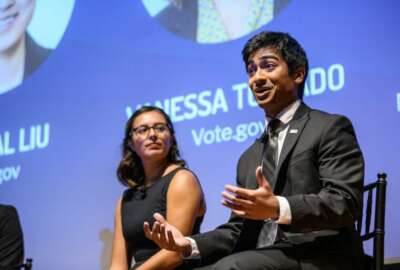
Lots of under-35s work for the government, just not in it
You'll find larger numbers of young people working on federal contracts rather than at the awarding agencies.
The refrain is familiar. Someone said it the other night at the Service to America medals ceremonies. Only a small percentage of the federal workforce is under 35 years old. Still tinier is the fraction under 30.
Yet untold numbers of younger workers are working for the government. They’re just not on the government payroll. They work for contractors, and they’re doing important and difficult work.
I have only anecdotal evidence and no numbers. But I think I’m right. This group may not join the ranks of policy or program analysts, contracting officers or contract auditors, but their work is directly on behalf of the government.
My anecdotes come from a weekend visit to my alma mater, the Rochester Institute of Technology. I sat on a panel of former school paper editors. RIT, once a regional training ground for printers, photographers, graphic artists and engineers, has become a world class center for a diverse set of fields including cybersecurity, imaging sciences, computer sciences, and environmental sustainability. It has maker spaces, start-up incubator centers, and additive manufacturing labs. Students graduate with useful skills — skills in demand by industry and government.
Here are two examples of what I started talking about:
For homecoming weekend, a little waist-high booth stood in the middle of the campus. There a student, Brandon, handed out programs for the day’s activities. I asked Brandon what he majors in: Cybersecurity. I said, well there’s plenty of government work there.
“That’s what I’m doing,” Brandon replied. He said we was working for Parsons Corporation under RIT’s co-op program. I know them, I said. They have a big building in Washington near the ballpark. “That’s where I work!” Brandon beamed.
I didn’t pester him on details, but he said he works for several federal agencies. Indeed, at its web site Parsons specifically states it’s hiring people in cybersecurity. It lists as its primary markets defense and intelligence. So there’s one young person doing federal work who doesn’t show up in the official counts.
Later in the morning I wandered into a brunch of the imaging sciences program. Still a student at heart, I thought, why not get a free breakfast? Besides, I majored in photography — that’s imaging.
There I chatted with Dan, a 2015 graduate. He’s working for Lockheed, developing imaging systems for the Navy’s submarines. Forget that old idea of the periscope with a lens on the front, a mirror on the bottom and a tube going through the hull of the boat. It’s all electronic imaging over fiber cabling now. No need for the periscope apparatus to have a hole through the tower.
Related Stories
DoD: Initial security clearance transfer complete, now real work begins
I ran my theory past a NASA executive at this week’s Imagine Nation ELC 2019 in Philadelphia, hosted by the American Council for Technology and Industry Advisory Council, or ACT-IAC. She said she gets a lot of queries from young people interested in federal work. She said she routinely refers them to the long list of NASA contractors.
To a programatically, but statistically insignificant degree, the 18F program at the General Services Administration and the U.S. Digital Service have brought under-35 and under-30 people into government. But the real numbers are out there in the contractors.
Copyright © 2024 Federal News Network. All rights reserved. This website is not intended for users located within the European Economic Area.
Tom Temin is host of the Federal Drive and has been providing insight on federal technology and management issues for more than 30 years.
Follow @tteminWFED





